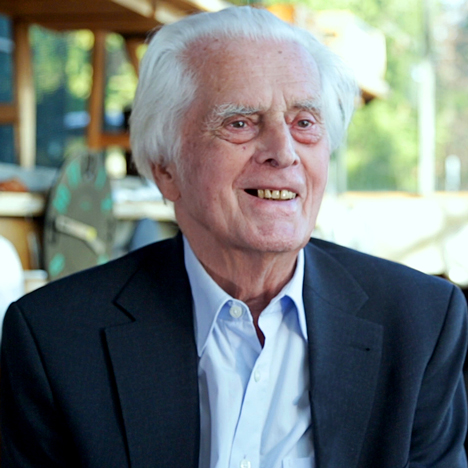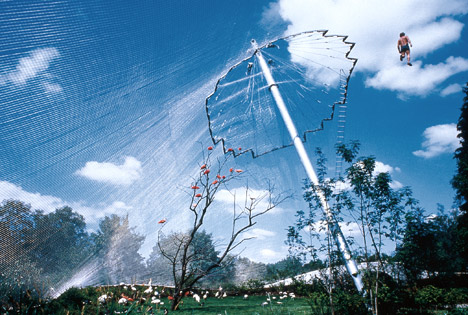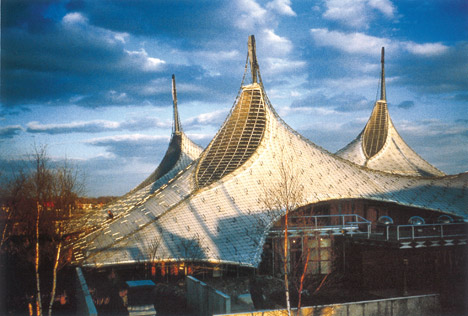
Hadid and Foster lead tributes to "great architect, inventor and gentleman" Frei Otto
Zaha Hadid has paid tribute to "inspirational and enlightening" late German architect Frei Otto, while Norman Foster said Otto's "extraordinary structures altered the nature of architectural form in the 20th century".
Foster added that Otto's "environmentalism, intelligence and foresight have established the defining architectural mentality for the 21st [Century]."
"We first met in Germany early in my career and he became a dear friend," Hadid told Dezeen, following news that the architect had posthumously been awarded the Pritzker Prize.
"His research and exploration of tensile structures was inspirational and enlightening, and his Pritzker is very well deserved," Hadid said. "Our joy of this news is some consolation for the loss of a great architect, inventor, educator and gentleman. Our thoughts are with his family at this time."
Otto, who died on Monday at the age of 89, was a pioneer in tensile and membrane architecture, developing curved tent-like structures that were designed to harness natural forces and use minimal materials.

Hadid, who has previously cited Otto as an influence on her own architecture, said the fluidity of his work "is as uplifting as it was profoundly inventive – a persuasive manifesto of nature's logic and unity, demonstrating how architectural design and engineering can emulate nature’s morphogenesis."
"The more our own design research evolves, the more we learn to appreciate his pioneering works," she added. "He will continue to influence architects and engineers for generations to come."
Norman Foster described Otto as an "inspiration", adding that he had actively supported Otto's nomination for the Pritzker prize.
"I was deeply saddened to hear that Frei Otto had passed away on Monday," Foster told Dezeen. "I had specifically written to the Pritzker Jury in support of his nomination for the Pritzker Prize."
Foster also sent Dezeen a tribute he had written for Otto's 80th birthday a decade ago. "Frei Otto showed us that architecture need not be burdened by the weight of its own traditions, but could instead be free to express itself through simple but innovative sculptural forms," the tribute said. "This sense of weightlessness, and of an architecture unbound by convention, was carried over into Frei's working relationships."
Foster continued: "Rather than working in isolation, he consistently advocated a freer role for the architect – whether this was as an educator, sharing his ideas with generations of students, or in practice, through valued joint projects with, or providing research support for, other architects and engineers.
"For me, he reinforced the point that architecture is a fundamentally collaborative exercise," Foster wrote. "His extraordinary structures altered the nature of architectural form in the 20th century, and his environmentalism, intelligence and foresight have established the defining architectural mentality for the 21st."

Chilean architect Alejandro Aravena, who was on this year's Pritzker jury, revealed that he too had written a personal citation to support Otto's nomination for the award.
"Frei Otto has created thoughout his life, not only imaginative, fresh, unprecedented spaces and constructions; he has also created knowledge," read the citation Aravena shared with Dezeen.
"Here resides his deep influence: not as forms that were copied but as paths that were opened by his research and discoveries. His contribution to the field of architecture in that sense, has been not only skilled and talented, but also a generous one."
Otto's best-known projects include the 1972 Munich Olympic stadium, the German pavilion for the 1967 World Expo in Montreal, and the soaring steel mesh aviary at Munich Zoo. He was known for his collaborative approach, forming career-long relationships with engineers and other architects, and was among the first adopters of 3D modelling.

From 1964 he led the Institute for Lightweight Structures at the University of Stuttgart, where he spearheaded research into using natural shapes and mathematical patterns to create new lightweight construction methods.
He was named as the 2015 Pritzker laureate – the architectural equivalent to winning a Nobel prize – on Tuesday, becoming the award's 40th recipient. The announcement was pulled forward by two weeks. A ceremony that was scheduled to take place in Miami on 15 May will go ahead, with plans to celebrate his life and work.
Update: Stefan Behnisch, son of architect Günter Behnisch who collaborated with Frei Otto on the stadium for the 1972 Olympics, has also sent a statement to Dezeen.
"Along with my partners at Behnisch Architekten, I congratulate Frei Otto on winning the 2015 Pritzker Prize and honor his lasting legacy," he said.
"Otto merits this prize for his visionary ideas, his innovative and unique structures, and his willingness to freely share his inventions and research conducted at his Institute for Lightweight Structures with other architects and engineers. He always helped his colleagues to implement their design concepts and supported them with a true collegial spirit.
"With his knowledge and creativity, Frei Otto worked closely with architect Behnisch & Partner, engineer Leonhardt und Andrä, and the clients, as well as numerous other parties. Together, they brought the roof structure proposed in the competition entry to reality, even though the feasibility of the design had long been doubted. Without Otto's advice and expertise, the project would not have been realised.
"We owe a profound debt of gratitude to Frei Otto, and admire and respect him for his lifelong achievements."